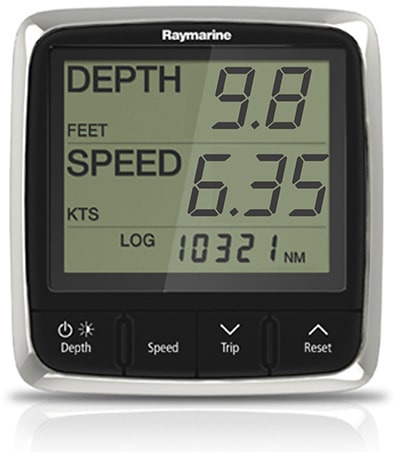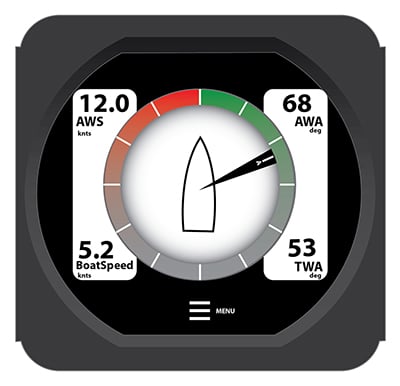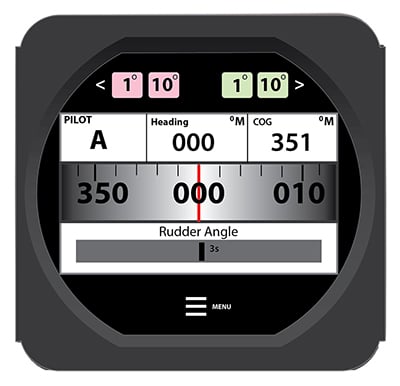
This article is an excerpt from NauticEd’s online Skipper Large Keelboats Course, a comprehensive online sailing course for beginner to intermediate sailors to learn how to sail large sailboats 26 ft (8m) and above. The Skipper Large Keelboats course is part of the Skipper Course Bundle of online courses, also teaching you how to master maneuvering under power and docking!
You can learn to sail and improve your sailing with NauticEd, the international leader in sailing education.
Key Sailboat Instruments
Sailboat Instrumentation can be very sophisticated and intelligent. Most electronic displays provide a wide range of menus of useful information.
Depth and Speed

Depth and Speed Meter
One of the key instruments you will constantly use is your depth and speed meter. The following is a typical device.
It shows that the depth of the water is 9.8 feet and the speed of the boat through the water is 6.35 knots. Take care to understand FROM where the depth is measured. Is it the water surface or is it the depth below the keel? For example, if your keel is 5 feet (1.7 m) deep from the waterline (aka your “draft”), your boat will hit bottom at 5 feet if the meter is set to the waterline. Therefore, it is wise to add an additional 5 feet (2 m) of safety factor to the depth meter – so that at a glance you know the depth below your keel, which is really the depth that determines whether you run aground.
Devices can get quite sophisticated and can map a bottom contour as well as depth, or simply an up/down arrow if the depth is increasing or decreasing. There are even forward-looking sonars that will display upcoming depths and underwater features.
Depth Animation
The speed measurement typically comes from an impeller mounted under the hull that spins from the passing water. The speed indicated is the speed through the water, not relative to the land. If you are operating in high current flow, your water speed will be quite different from your speed relative to the land (speed over ground).
Your GPS device will also have a speed measurement. This is the speed over ground and can be very accurate. When there is no current, the speed from your depth and speed meter (via its impeller) and the speed from the GPS should match. If they do not match, clean your water impeller since it can become clogged with algae—which affects the measurement. Prudent sailors check and clean their impellers often.
Wind Instrument
Another key instrument used on larger sailboats is a wind meter that receives its information from a spinning anemometer at the top of the mast. It presents the wind direction and speed information to you in a display in the cockpit.
The wind meter needle points to the direction of the wind and can be set to indicate apparent wind or true wind. It can also give other useful information controlled by the menu settings, such as wind speeds.
In the image here the apparent wind speed is 12 knots at an angle of 68 degrees from starboard.

Wind Meter
Autopilot
An autopilot is an extremely useful device, especially when single-handling a boat. It gives you pertinent information but also allows you to make fine adjustments to your heading to port or starboard by touching the 1 or 10-degree buttons.
When the autopilot is connected to the GPS device, it can also steer automatically to waypoints that you set up in the GPS.
Some autopilots automatically steer the boat to maintain a constant wind angle.
Do not attempt to turn the wheel when an autopilot is engaged. You can damage the electric servo connections to the wheel.

Autopilot
GPS and navigation instruments will be covered later in Chapter 9, Navigation.
You can learn more in the Skipper Course....
Knowledge and theory for longer distances and overnight sailing in diverse conditions. The Skipper Course is a comprehensive online sailing course for beginner to intermediate sailors wanting to learn how to sail larger sailboats 26ft to 56ft. Or upgrade to the Skipper Course Bundle of online courses to also master maneuvering under power and docking!
